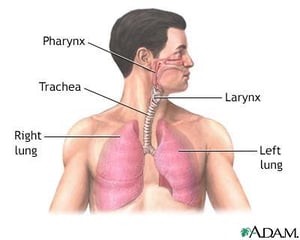Tracheal Stenosis
What is tracheal stenosis?
The trachea, or windpipe, carries air from the nose to the lungs. Stenosis means narrowing. In tracheal stenosis, the trachea is narrow. This may make it hard to breathe.
Cartilage is a flexible tissue in the body. The trachea stays open because of the cartilage that supports it. The cartilage in the trachea makes C-shaped rings in front of the trachea. There is usually no cartilage in the back of the trachea.
There are two types of stenosis: 
- Short-segment tracheal stenosis. There is a small area of narrowing in only 2 to 3 rings.
- Long-segment tracheal stenosis. The cartilage may have formed a complete or O-shape instead of C-shape. This causes a long part of the windpipe to be narrow.
What causes it?
- Normally, a child is born with it. This is called congenital stenosis and means the child was born with a narrow trachea. Long-segmented stenosis is often congenital.
- Tracheal stenosis may also be caused as a result of:
- Direct injury to the trachea.
- Trauma from being intubated for a long time.
- Infection of the trachea.
What are the symptoms?
- Noisy breathing that comes from the neck. This is called stridor.
- Breathing stops during sleep. This is called apnea.
- Turning blue, also called cyanosis.
- Wheezing.
- Repeated croup or pneumonia illnesses.
How is it diagnosed?
- A bronchoscopy is done to look at the inside of the trachea. It is done under anesthesia. A long tube called a bronchoscope is used. It helps the doctor understand more about the tracheal narrowing and what is causing it.
- A special x-ray, such as a CT scan or MRI, may also be done. These x-rays show more detailed images of the trachea and lungs.
- If the doctor thinks there may be heart problem, an echocardiogram (echo) will be done. This is a test that checks the heart and blood vessels. It may be done on the outside of the chest or through the swallowing tube (esophagus). No incisions are made during the test.
How is it treated?
Treatment depends on how many tracheal rings are present and how bad the symptoms are. If it’s mild, the doctor may watch and wait to see if symptoms improve. Medicines may be recommended to improve breathing problems.
Surgery may be needed.
- Dilation of the airway may be suggested.
- With short-segment stenosis, the affected rings can be taken out and the two healthy ends can be sewn together.
- In long-segment stenosis, a procedure that widens the airway may be done. It is called a slide tracheoplasty and it makes breathing easier.
After surgery, your child may go to the Intensive Care Unit (ICU) to recover. The doctor may insert a breathing tube down the throat for a short time. This is called intubation and will help your child breathe while the trachea heals. Medicine will also be given to keep your child sleepy or still for several days. Your child may have another bronchoscopy to see how the trachea is healing.
Your child will go home when the airway is healed enough to keep breathing comfortably. Your child’s doctor will decide when a follow-up bronchoscopy is needed to check the progress.



